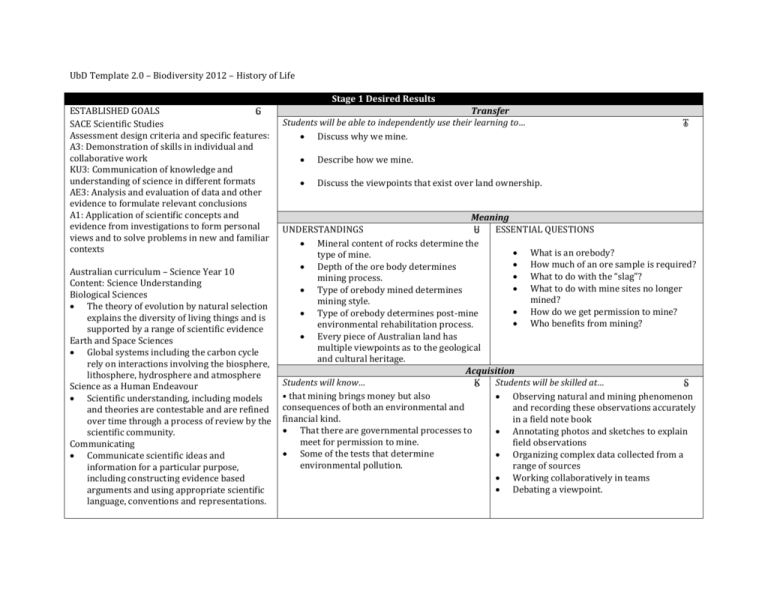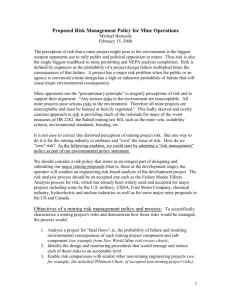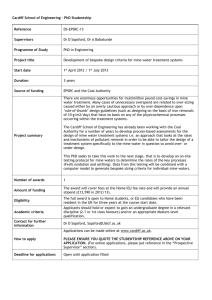UbD Template 2.0 – Biodiversity 2012 – History of Life Stage 1
advertisement

UbD Template 2.0 – Biodiversity 2012 – History of Life Stage 1 Desired Results ESTABLISHED GOALS G ○ SACE Scientific Studies Assessment design criteria and specific features: A3: Demonstration of skills in individual and collaborative work KU3: Communication of knowledge and understanding of science in different formats AE3: Analysis and evaluation of data and other evidence to formulate relevant conclusions A1: Application of scientific concepts and evidence from investigations to form personal views and to solve problems in new and familiar contexts Australian curriculum – Science Year 10 Content: Science Understanding Biological Sciences The theory of evolution by natural selection explains the diversity of living things and is supported by a range of scientific evidence Earth and Space Sciences Global systems including the carbon cycle rely on interactions involving the biosphere, lithosphere, hydrosphere and atmosphere Science as a Human Endeavour Scientific understanding, including models and theories are contestable and are refined over time through a process of review by the scientific community. Communicating Communicate scientific ideas and information for a particular purpose, including constructing evidence based arguments and using appropriate scientific language, conventions and representations. Transfer Students will be able to independently use their learning to… Discuss why we mine. Describe how we mine. Discuss the viewpoints that exist over land ownership. T ○ Meaning UNDERSTANDINGS U ESSENTIAL QUESTIONS ○ Mineral content of rocks determine the What is an orebody? type of mine. How much of an ore sample is required? Depth of the ore body determines What to do with the “slag”? mining process. What to do with mine sites no longer Type of orebody mined determines mined? mining style. How do we get permission to mine? Type of orebody determines post-mine Who benefits from mining? environmental rehabilitation process. Every piece of Australian land has multiple viewpoints as to the geological and cultural heritage. Acquisition Students will know… K Students will be skilled at… S ○ ○ • that mining brings money but also Observing natural and mining phenomenon consequences of both an environmental and and recording these observations accurately financial kind. in a field note book That there are governmental processes to Annotating photos and sketches to explain meet for permission to mine. field observations Some of the tests that determine Organizing complex data collected from a environmental pollution. range of sources Working collaboratively in teams Debating a viewpoint. Year 10 Achievement Standard Develop questions and improve appropriate methods of investigation, including field work. When analyzing data, selecting evidence and developing conclusions they identify alternative explanations for findings and explain and sources of uncertainty. They construct evidence based arguments and select appropriate representations and text types to communicate science ideas for specific purposes. Evaluative Criteria The extent to which students: Demonstrate constructive and focused collaborative work skills Use logical and clear expression Use appropriate language and format Use a range of references cited correctly using the Harvard Referencing System Develop ideas and arguments logically and in depth with evidence of the interconnectedness of concepts Use evidence from a variety of sources to support a personal position Justify of a point of view using supporting evidence Stage 2 – Evidence Assessment Evidence TRANSFER TASK(S): TT ○ Brukunga Mine Field Trip and Summative Issues task Field Note Book Activity 1: Tour of mine site o Introduction to the history of the mine o Tour of mine area and rehabilitation/remediation measures o Collection of copper sulphide ore s amples from mine Pyrite is an iron sulfide with the formula FeS2. Pyrrhotite an unusual iron sulfide mineral with a variable iron content: Fe(1-x)S (x = 0 to 0.2). Pyrrhotite is also called magnetic pyrite because the color is similar to pyrite and it is weakly magnetic. The magnetism increases as the iron content decreases. Activity 2: Water quality testing of pH, copper and iron levels o Upstream o Waste rock (tailings) runoff o Settlement pond o Treated water Summative Issues task In this task you will be provided with a scenario of a mine and/or processing plant. You will be given a role/character and will address the issues (positive and negative) relevant to this role/characters. The concluding performance will be a public forum where community members can have their say. For your character you will need to: 1. Identify and Explore the positive and negative aspects of the proposed mine using the scenario provided. This is probably best done using a mind map, although there is many ways to do this. 2. Summarise your position in a letter requesting an opportunity to speak at the Public Forum. These will be shared among all members of the public forum. 3. Explain and Justify your position in a 5min presentation at the public forum, including your ‘personal’ ‘views on what would be the next step, what could solve any issues etc. 4. Summarise your resources used with an annotated reference list. The annotation should include a summary of the information used i.e. ‘This resource was very useful for a background into the Field River’ Can students: Justify their personal point of view. Sequence the consequences of mining in a suburban area. Effectively support their view with references. Stage 3 – Learning Plan Summary of Key Learning Events and Instructions Activity One - Visit to Brukunga Mine View the site here Read this article to learn more about the background and issues involved with the mine site. This is the PowerPoint that will be used at Brukunga. This report provides the 2010 Environmental Monitoring results and is useful for comparing our water quality results. This field note book will be used during your excursion for you to record your observations and thoughts and water quality test results Activity Two - Issues in Mining In this activity, you will be provided with the following mining scenario. Your teacher will assign you to a role within the community and you will need to act as this role for the nonSACE and SACE tasks. The assessment requirements and rubric are to be found in the task handout. You may want to investigate the following case-studies to develop your understanding of issues in mining o Environmental: The Brukunga mine site visit was a key example of the negative environmental outcomes from mining. The o o o PowerPoint used at the mine on the excursion is available here. Cultural and Environmental Heritage: The potential mining of Arkaroola was prevented largely on the grounds of it's immense cultural and environmental heritage. This case study looks at what these factors are and how they can be impacted by mining. Land Ownership: Mines need to be somewhere, and chances are, it is owned by someone. This case study looks at different views of land ownership, including an indigenous perspective. Health Impacts: The potential effects of mining of the health of workers and people living close to the mine site or infrastructure is explored in this case study about Pt Pirie. This case study looks at article 1, article 2, article 3, article 4 and article 5. o You may want to use the following links in your issues investigation. o The mine site can be viewed on Google earth at the following coordinates, (which are half way between a stack and pump house): 35° 5'15.06"S, 138°30'39.89"E. It can alo be found by travelling east from the Hallett Cove Sporting Clubs until you hit the Field River. o General information about the area, and the history of the mine. This website has some more history information as well. o The Friends of the Field River have a detailed site that looks at the local environment you may remember we visited the Field River estuary as part of Biodiversity, Evolution field trip. There are a number of environmental projects such as this one between Hallett Cove Schools and The Friends of the Field River. o Information about Nyrstar can be found on their website, while this fact sheet on Port Pirie summarises their South Australian operations. o The Minerals Council of Australia website has some useful info, particularly their statements on sustainable development. o This site provides a list of the main minerals mined at the Worthing (Hallett) Mine - research each of these and suggest what issues may be involved with the extraction and refining of each mineral. o The Marion Council has proposed a 'Great Southern Urban Forest' that includes the site of the proposed mine. The most useful pages are probably pg 29, 34, 36 and 42.








